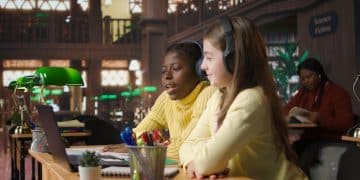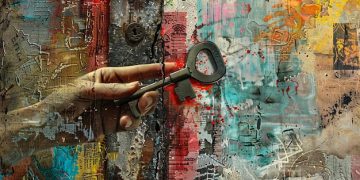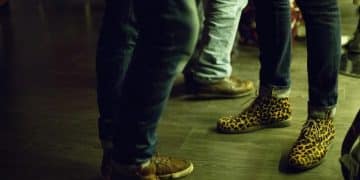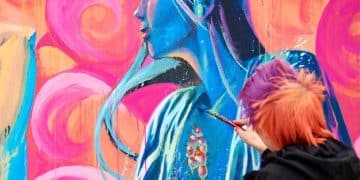Graffiti Art & Education: Engaging US Students in Schools
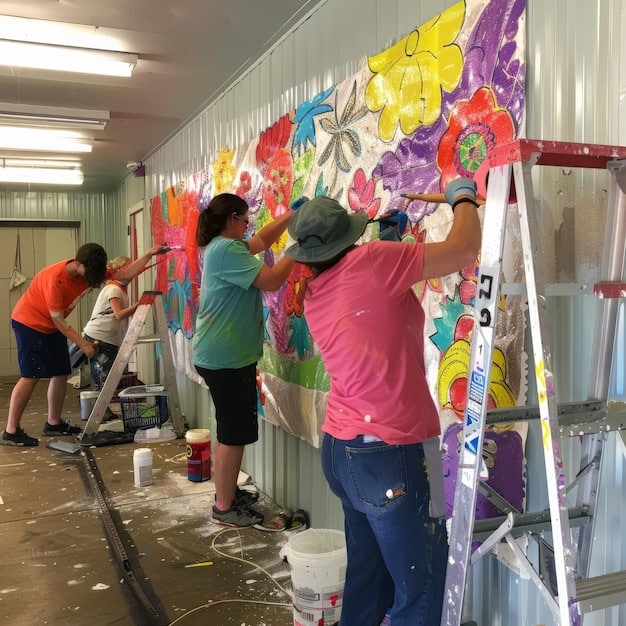
Schools in the US can leverage graffiti art as an innovative educational tool, fostering student engagement, creativity, and critical thinking while embracing a culturally relevant and often misunderstood art form, bridging academic learning with contemporary artistic expression for enhanced pedagogical outcomes.
In the evolving landscape of education, traditional pedagogical methods sometimes struggle to capture the imagination of every student. However, an unexpected avenue, Graffiti Art and Education: How Can Schools Use Graffiti Art to Engage Students in the US?, offers a compelling solution. This dynamic art form, often relegated to the peripheries of formal art, possesses a raw energy and cultural resonance that could revolutionize classroom engagement.
The Rebellious Roots: Understanding Graffiti Art’s Educational Potential
Graffiti art, with its often subversive origins and association with urban culture, might seem an unlikely candidate for integration into school curricula. However, dismissing it outright overlooks its rich history, diverse styles, and profound impact as a form of social commentary and artistic expression. Understanding its rebellious roots is crucial to unlocking its educational potential within a structured environment.
Historically, graffiti emerged from a need for expression—a voice for the voiceless. From ancient civilizations scratching messages on walls to the vibrant street art scenes of New York City in the 1970s and 80s, it has consistently challenged norms and asserted identity. This inherent desire for self-expression is a powerful force that educators can harness.
Deconstructing Narratives: Beyond Vandalism
One of the primary challenges in integrating graffiti art into schools is overcoming the pervasive stereotype of vandalism. Many view it solely as an act of destruction, rather than a creative endeavor. Educating students, parents, and administrators about the distinction between illicit tagging and legitimate artistic expression is paramount. This requires a nuanced discussion about context, intent, and community impact.
- Historical Context: Exploring the evolution of graffiti from prehistoric cave paintings to modern street art.
- Artistic Movements: Connecting graffiti to cubism, abstract expressionism, and pop art, highlighting its place within art history.
- Social Commentary: Analyzing how graffiti artists use their work to address political, social, and economic issues.
- Technique and Style: Showcasing the sophisticated techniques, typography, and color theory employed by renowned graffiti artists.
By reframing the narrative, schools can transform perceived threats into opportunities for meaningful learning. It’s about shifting perception from “defacement” to “public discourse,” from “illegality” to “creative freedom within boundaries.” This change in perspective is foundational for any successful educational program involving graffiti art.
Embracing graffiti art in education means acknowledging its power to engage students who might otherwise feel disconnected from traditional art forms. Its contemporary relevance and undeniable cool factor can make art class, and indeed other subjects, more appealing and impactful for a diverse student body.
Creative Expression and Identity Formation: A Medium for Youth
For many young people, traditional art classes can feel restrictive, rigid, or irrelevant to their lives. Graffiti art, however, resonates deeply with youth culture because of its innate connection to identity, rebellion, and self-expression. It offers a unique and powerful medium through which students can explore their identities, communicate complex emotions, and articulate their perspectives on the world around them.
In a world where digital communication often dominates, the tangible act of creating a large-scale artwork can be incredibly liberating. It provides an outlet for energy, frustration, and joy, fostering a sense of accomplishment that is both personal and communal. This goes beyond simple artistic skill development; it taps into deeper psychological needs for recognition and belonging.
Empowering Voices: Art as Dialogue
Graffiti art can serve as a catalyst for dialogue, allowing students to address issues pertinent to their lives and communities. Instead of simply consuming information, they become producers of cultural content, contributing to a visual narrative that reflects their experiences. This engagement can lead to a deeper understanding of civic responsibility and the power of art to instigate change.
- Self-Expression: Providing a non-traditional outlet for students to express feelings, ideas, and personal stories.
- Cultural Relevance: Connecting with students from diverse backgrounds by acknowledging and integrating a form of art they encounter daily.
- Identity Exploration: Encouraging students to reflect on who they are and how they fit into the world through visual storytelling.
- Peer Connection: Fostering collaboration and shared purpose as students work together on large-scale projects.
When students see their own experiences or cultural touchstones reflected in the curriculum, they are far more likely to engage. Graffiti art, often born from lived experiences in urban environments, offers this critical connection. It validates their experiences and shows them that their art, and their voice, matters.
Ultimately, incorporating graffiti art into education is about empowering students. It’s about giving them the tools and the space to find their voice, to tell their stories, and to leave their mark in a positive and constructive way, channeling their creativity into socially responsible endeavors.
Integrating Graffiti Art into Curricula: Practical Approaches
Successfully integrating graffiti art into school curricula requires thoughtful planning and practical strategies that align with educational objectives while respecting the art form’s unique characteristics. It’s not about encouraging illicit behavior, but about channeling artistic energy into legitimate, educational, and community-enriching projects.
Schools can begin by establishing clear guidelines and providing appropriate resources. This might involve setting up designated areas for murals, securing necessary materials like spray paint and stencils, and inviting experienced local artists to mentor students. The key is to create a safe, supportive, and stimulating environment for experimentation and learning.
Beyond the Canvas: Interdisciplinary Learning Opportunities
The beauty of graffiti art’s educational potential lies in its interdisciplinary nature. It can be woven into various subjects, making learning more dynamic and relevant. This cross-curricular approach enhances understanding and allows students to see connections across different fields of study.
- Art History: Study origins, styles, and influential artists (e.g., Jean-Michel Basquiat, Keith Haring, Banksy).
- Social Studies/Civics: Analyze art as social commentary, historical documentation, or a tool for activism.
- Language Arts: Explore the use of text, symbolism, and narrative in murals; creative writing inspired by street art.
- Mathematics: Apply concepts of proportion, scale, and geometry in designing murals.
- Science/Chemistry: Investigate paint composition, aerosol technology, and environmental considerations.
Project-based learning is particularly effective when working with graffiti art. Students can research, design, and execute murals that address specific themes or community issues, transforming theoretical knowledge into practical application. This hands-on experience solidifies learning and builds valuable skills.
Collaboration with community organizations and local artists can further enrich these programs. Artists can provide real-world insights, demonstrate techniques, and inspire students, creating authentic learning experiences that extend beyond the classroom walls. These partnerships also help to bridge the gap between school and the wider community.
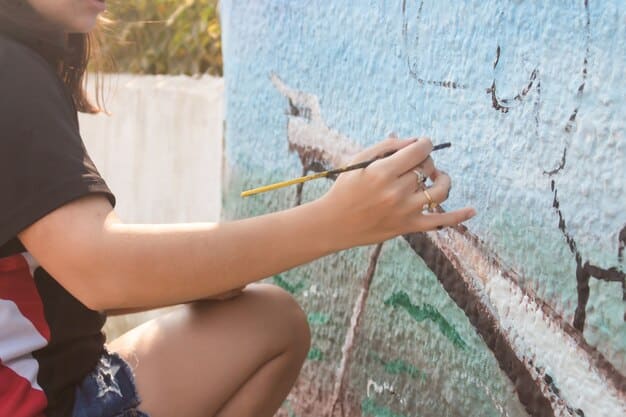
Community Engagement and Positive Impact: Murals as Connectors
Beyond the direct impact on students, integrating graffiti art into schools presents a significant opportunity for community engagement and positive social change. Public art, particularly murals created by students, can transform neglected spaces, foster a sense of collective ownership, and serve as powerful visual expressions of community values and aspirations.
When students contribute to public art projects, they gain a tangible connection to their surroundings. They see their efforts beautify their environment and spark conversations, reinforcing the idea that their actions can have a visible and beneficial impact on their community. This can be profoundly empowering.
Transforming Spaces: Art for Social Good
Blank walls, dull corridors, or underutilized spaces within schools or local neighborhoods can become vibrant canvases for student-led mural projects. These transformations not only enhance aesthetics but can also deter unwanted tagging by fostering a sense of shared pride and respect for the artwork.
- Beautification Projects: Creating murals in schools, community centers, or local businesses.
- Thematic Murals: Designing art that promotes positive messages (e.g., anti-bullying, environmental awareness, local history).
- Intergenerational Projects: Collaborating with local seniors or community groups on mural designs.
- Public Art Installations: Participating in larger city-wide art initiatives, giving students broader exposure.
These projects require students to engage with their community, conduct interviews to understand local needs, and present their ideas to stakeholders. This process develops critical communication, negotiation, and project management skills—all vital for future success.
The murals themselves become conversation starters, generating pride among students, faculty, and local residents. They can serve as landmarks, tell stories, and reflect the unique character of a community, making abstract concepts of civic engagement real and visible.
By channeling the raw energy of graffiti into constructive community projects, schools can demonstrate the art form’s power to unite people and create lasting positive change. It bridges generational gaps and fosters a shared sense of identity and belonging through artistic expression.
Addressing Challenges: Navigating Perceptions and Practicalities
While the benefits of incorporating graffiti art into education are compelling, schools must proactively address the inherent challenges and concerns. These typically revolve around public perception, potential misinterpretations, and the practicalities of managing such projects within an educational setting. Open communication and clear guidelines are essential.
One major hurdle is obtaining buy-in from all stakeholders—administrators, parents, and community members. Many may harbor negative associations with graffiti, viewing it primarily as illicit vandalism rather than a legitimate art form. Educational initiatives must therefore be accompanied by robust awareness campaigns and clear distinctions between sanctioned art and illegal acts.
Policy and Permission: Setting Clear Boundaries
Establishing clear policies and obtaining necessary permissions are crucial for the successful implementation of any graffiti art program. This involves defining designated areas for artistic expression, outlining materials usage, and setting expectations for content and themes. Transparency can help alleviate concerns and build trust.
- Curriculum Development: Designing lessons that distinctly separate legal, educational graffiti art from illegal tagging.
- Permission Protocols: Requiring parental consent and formal school/community approval for all projects.
- Safety Guidelines: Implementing strict safety measures for handling spray paints and equipment.
- Copyright and Attribution: Educating students on artistic integrity, plagiarism, and respecting others’ work.
Practical considerations also include budgeting for materials, ensuring proper ventilation for spray paint use, and providing adequate supervision. Schools might also consider working with local law enforcement or community leaders to ensure their initiatives are understood and supported as positive, educational endeavors.
By meticulously planning and addressing these challenges head-on, schools can transform potential obstacles into opportunities for deeper engagement and stronger community ties. It demonstrates a commitment to thoughtful innovation rather than reckless abandon. The process of navigating these challenges itself can be a valuable learning experience for students, teaching them about planning, advocacy, and problem-solving within a complex social context.
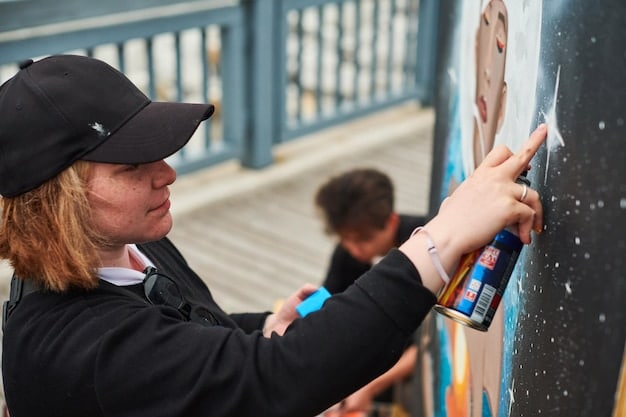
Future Outlook: Graffiti Art as a Staple in US Education
Looking ahead, the integration of graffiti art into US education is poised for significant growth, evolving from a niche or experimental approach to a recognized and valuable component of a comprehensive arts education. As society continues to embrace diverse forms of artistic expression and emphasize culturally relevant pedagogy, the potential for graffiti art to become a staple in schools is immense.
The shift in perception, driven by increased public access to and appreciation for street art in urban centers, will likely facilitate its acceptance in educational institutions. Galleries worldwide now showcase works by established graffiti artists, validating the art form as a legitimate and powerful medium worthy of academic study.
Advocacy and Evolution: Shaping Tomorrow’s Curricula
Continued advocacy from educators, artists, and community leaders will be critical in pushing for broader adoption. Demonstrating the tangible positive impacts—from increased student engagement to community beautification—will build a compelling case for its expansion. The evolution of educational tools and resources, including digital platforms and specialized art supplies, will also make implementation more accessible.
- Teacher Training: Developing professional development programs for educators in street art techniques and pedagogy.
- Standardized Curricula: Creating national or state guidelines for integrating graffiti art into K-12 art programs.
- Research and Data: Documenting the academic and social benefits through empirical studies to build a stronger case.
- Artist Residency Programs: Fostering more partnerships between schools and professional graffiti artists.
The future also involves a deeper exploration of the ethical dimensions of graffiti art, encouraging students to consider the impact of their work on public spaces and fostering a sense of artistic responsibility. This includes discussions around public vs. private property, artistic freedom vs. community consent, and the transient nature of street art.
Ultimately, the goal is to cultivate a new generation of visually literate citizens who can appreciate, analyze, and ethically contribute to the diverse tapestry of public art. By embracing graffiti art, schools are not just teaching a new art form; they are fostering creativity, critical thinking, civic responsibility, and a deeper connection to contemporary culture. It’s about preparing students for a world where art is not just confined to museums, but is an active, living part of their environment.
| Key Point | Brief Description |
|---|---|
| 🎨 Creative Outlet | Graffiti offers a unique, engaging medium for student self-expression and identity formation in schools. |
| 🤝 Community Impact | Student-led murals beautify spaces and foster civic pride, connecting schools with local communities positively. |
| 📚 Interdisciplinary Learning | Integrates art with history, social studies, and math, enriching curriculum and enhancing engagement. |
| ⚖️ Perception Shift | Educates on the distinction between illicit tagging and legitimate artistic expression, fostering respect for the art form. |
Frequently Asked Questions About Graffiti Art in US Education
▼
Graffiti art is highly engaging for students, particularly those who may feel disengaged by traditional methods. It connects directly with youth culture, providing a relevant and dynamic outlet for self-expression. It can foster creativity, critical thinking, and problem-solving skills through hands-on projects and interdisciplinary studies, bridging the gap between academic subjects and real-world relevance. It also helps in demystifying an often misunderstood art form.
▼
Distinction is crucial. Legitimate educational graffiti art is created with permission, within designated spaces, and often with an educational objective. Vandalism, conversely, is unauthorized marking on property. Schools must establish clear guidelines, teach students about legal and ethical considerations, and emphasize that school-sanctioned projects are distinct from illicit acts, focusing on context, intent, and community impact.
▼
Graffiti art offers vast interdisciplinary potential. Beyond visual arts, it can be integrated into art history (examining its evolution and famous artists), social studies/civics (analyzing social commentary and activism), language arts (exploring narrative and symbolism), and even mathematics (applying concepts of scale and geometry in mural design). This cross-curricular approach enriches learning and connects diverse subjects.
▼
Engaging actively in graffiti art empowers students to find their voice and express complex ideas visually. The tangible creation of large-scale artworks, especially those displayed publicly, instills a strong sense of accomplishment and pride. It validates their cultural experiences and allows them to explore their identities through a medium that feels authentic and relevant, significantly boosting self-esteem and artistic confidence.
▼
Schools may face challenges such as overcoming negative public perception tied to vandalism, securing administrative and parental buy-in, and addressing practicalities like budget for materials, ventilation for spray paints, and proper supervision. Clear communication, establishing strict guidelines, and emphasizing the educational and community benefits are key to navigating these hurdles and ensuring program success. Community partnerships can also help.
Conclusion
The integration of graffiti art into US schools represents a bold, forward-thinking approach to education, one that acknowledges the evolving nature of artistic expression and its profound connection to contemporary youth culture. By moving beyond outdated stereotypes and embracing its vast educational potential, schools can unlock new avenues for student engagement, foster unparalleled creative expression, and deliver impactful interdisciplinary learning experiences. The benefits extend far beyond the classroom, cultivating civic pride through community projects and nurturing a generation of critical thinkers who understand the power of art to communicate, challenge, and connect. Truly, graffiti art offers a vibrant canvas for the future of education.
